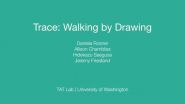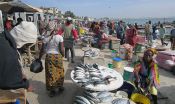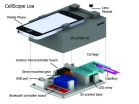(Press-News.org) Creative athletes have been using geographic information systems to transform their running routes into kangaroos, robots and other works of art that they share online, and one romantic cyclist last year even spelled out "Will you marry me, Emily?" with his bike.
A new mobile app developed at the University of Washington does the opposite. The Trace app turns a digital sketch that you draw on your smartphone screen -- a heart, maple leaf, raindrop, sailboat -- into a walking route that you can send to a friend or loved one. The recipient of the "gift" tells the app how long they want the walk to last and receives step-by-step directions that eventually reveal the hidden shape on a map.
The sender can also include audio recordings, images, inside jokes or other messages that pop up at specified locations along the route to give the recipient hints.
The free app, available from Google and iTunes, was designed by UW Human Centered Design and Engineering researchers to explore how GIS mapping technology shapes how we experience the simple act of walking. Trace aims to encourage communication and reflection, rather than focusing on competition or efficiency.
"For some people it was a delight to find that slowing down allowed them to meet new people or see familiar sites in their neighborhood in new ways, but at the same time giving up that control was a stress for other folks who had a routine, " said project lead Daniela Rosner, assistant professor of Human Centered Design and Engineering and co-director of the UW's TAT Lab.
Activity tracking apps like FitBit help people reach exercise goals, and routing apps like Google Maps are optimized to send people on the most efficient route to a particular destination. Trace, by contrast, forces walkers to relinquish control, go where the app directs them and in some cases experience traveling through a city quite differently than they're used to.
In a study presented last month in Seoul at the Association for Computing Machinery's CHI conference for computer-human interaction, 16 avid walkers in Seattle, Boston and Chicago who used Trace for a week tested more than 150 shapes. Some participants -- who included a dog walker, an artist, a Massachusetts Bay Transportation Authority employee and a lawyer who works on rights to public space -- sent routes to friends while others simply used the app to draw walks for themselves.
In one instance, a woman who met her boyfriend at a French cultural center in Boston sent him a walk that traced the outline of the United States, the country that brought them together. Along the way, she included hints to the mystery pattern, like "The Star-Spangled Banner." The two walked the route together in downtown Boston on a Sunday afternoon.
Unlike other apps that allow you to share a fixed route that you may have already run or biked, Trace allows a person to begin walking the route from any point in the city. The walker can also make the shape bigger or smaller by specifying how long the walk should last.
Some people found that using Trace introduced a different pace into their daily routines. One found himself in neighborhoods that he usually biked or ran through, but rarely walked. Others discovered new paths to local parks in their neighborhoods, or found time to engage with kids and neighbors as they paused to wait for the next direction. Rediscovering features that they often overlooked in their everyday environments invited unexpected surprises.
On the other hand, participants also found Trace to be deeply disruptive to familiar routines. It forced them to walk without having a clear sense of where they were going, and some shapes forced them to walk up and down the same street more than once, all of which felt disturbingly inefficient.
"We've sort of lost interest in exploring the same path two different ways, even though you can retrace your steps and have a different experience," Rosner said. "That deep-seated need for efficiency says something about what we expect from our tools and what maybe our tools have enabled us to expect."
In other instances, Trace routed people into neighborhoods that they perceived as unsafe or that made them feel uncomfortable. Those were among the times that people abandoned their walks. As some GIS routing apps have begun to experiment with using crime data to steer people away from certain neighborhoods, those algorithms raise questions about what becomes a discriminatory act, Rosner said.
"Our goal for this research wasn't necessarily to produce the next new app for walking, though we hope people will use and enjoy it," Rosner said. "It was to use the tool to start asking questions about what we expect from our GIS routing tools and about the role that technology can play in our walks."
INFORMATION:
Co-authors are UW master's students Hidekazu Saegusa and Allison Chambliss and recent graduate Jeremy Friedland.
The research was funded by Intel.
Web version with video and images:
http://www.washington.edu/news/2015/05/06/uw-mapping-app-turns-art-into-a-sharable-walking-route/
FROM: Jennifer Langston
University of Washington
206-543-2580
jlangston@.uw.edu
(NOTE: researcher contact information at end)
For more information, contact Rosner at dkrosner@uw.edu.
Scientists at the National Institutes of Health have solved a long-standing mystery about the origin of one of the cell types that make up the ovary. The team also discovered how ovarian cells share information during development of an ovarian follicle, which holds the maturing egg. Researchers believe this new information on basic ovarian biology will help them better understand the cause of ovarian disorders, such as premature ovarian failure and polycystic ovarian syndrome, conditions that both result in hormone imbalances and infertility in women.
Researchers at the ...
The Alaska salmon fishery is touted as one of the best in the world. When measured with an ecological yardstick, it is - fish stocks are healthy and the fishery is certified by the Marine Stewardship Council as consistently meeting rigorous biological standards. Fish are individually counted as they swim upstream to ensure there are enough to breed.
But Alaska salmon falls short and lags behind some of the world's fisheries in how it benefits local fishermen, processing workers and nearby rural communities, according to a new assessment that ranks the vitality of a fishery ...
Diets of snakes from a temperate region in South America may depend more on phylogeny (ancestry) than ecology, according to a study published May 6, 2015 in the open-access journal PLOS ONE by Gisela Bellini from Instituto Nacional de Limnología, Argentina and colleagues.
Some scientists believe that the deep history hypothesis based on phylogeny -- the history of evolution, or ancestry and relationships between snakes -- and ecological interactions from the competition-predation hypothesis may act together to determine the structure of snake communities. The authors ...
Post-surgical leaks that develop after a segment of the colon has been removed and stitched back together often are caused not by negligence or technical error but by bacteria in the bowel that elude antibiotics, according to new evidence about this devastating complication of gastrointestinal surgery.
Such leaks, which can develop days or weeks after the procedure, allow the bowel's contents to spill into the abdomen and can cause pain, fever, sepsis and even death.
In patients undergoing high risk surgery such as in the rectum, leak rates can approach 30 percent. ...
Berkeley -- A research team led by engineers at the University of California, Berkeley, has developed a new mobile phone microscope that uses video to automatically detect and quantify infection by parasitic worms in a drop of blood. This next generation of UC Berkeley's CellScope technology could help revive efforts to eradicate debilitating diseases in Africa by providing critical information for health providers in the field.
"We previously showed that mobile phones can be used for microscopy, but this is the first device that combines the imaging technology with ...
The rise of antibiotic-resistant bacteria is a growing problem in the United States and the world. New findings by researchers in evolutionary biology and mathematics could help doctors better address the problem in a clinical setting.
Biologist Miriam Barlow of the University of California, Merced, and mathematician Kristina Crona of American University tested and found a way to return bacteria to a pre-resistant state. In research published in the open-access journal PLOS ONE, they show how to rewind the evolution of bacteria and verify treatment options for a family ...
Scientists from the National Institute of Allergy and Infectious Diseases (NIAID), part of the National Institutes of Health, and the University of California, Berkeley, and colleagues have developed a mobile phone microscope to measure blood levels of the parasitic filarial worm Loa loa. The point-of-care device may enable safe resumption of mass drug administration campaigns to eradicate the parasitic diseases onchocerciasis (river blindness) and lymphatic filariasis (elephantiasis).
Efforts to eliminate these diseases in Central Africa through community-wide administration ...
Just witnessing aggression or other bad behaviour at work can affect our well-being, but the right support from employers and colleagues can limit the consequences.
That is the conclusion of research being presented today, Thursday 7 May 2015, by Dr Christine Sprigg from the Institute of Work Psychology at the Sheffield University Management School at the Annual Conference of the British Psychological Society in Liverpool.
Dr Sprigg and her colleagues surveyed 127 British employees who had witnessed aggression at work. Employees were asked to complete a number of psychological ...
Psychologists are to improve online health information on lung cancer after research showed that family members are more likely to search online to encourage loved ones to seek help.
This is one of the outcomes from research by PhD student Julia Mueller based in the School of Nursing, Midwifery and Social Work at The University of Manchester (part of the Manchester Cancer Research Centre) who will present her study today, Thursday 7 May 2015, at the Annual Conference of the British Psychology Society being held in Liverpool.
Julia Mueller said: "People displaying ...
Children are more likely to display troublesome behaviour in families in which the father feels unsupported by his partner.
The findings by Doctoral Researcher Rachel Latham from the University of Sussex will be presented today, Thursday 7 May 2015, at the Annual Conference of the British Psychology Society being held in Liverpool.
The ways in which parents work together in their roles has been shown to be an important factor in relation to the behaviour of their children. However, few studies have distinguished between mothers' and fathers' perceptions of the support ...





